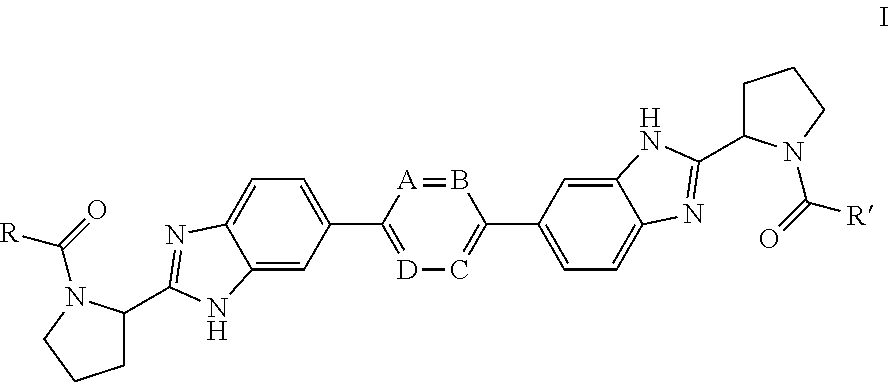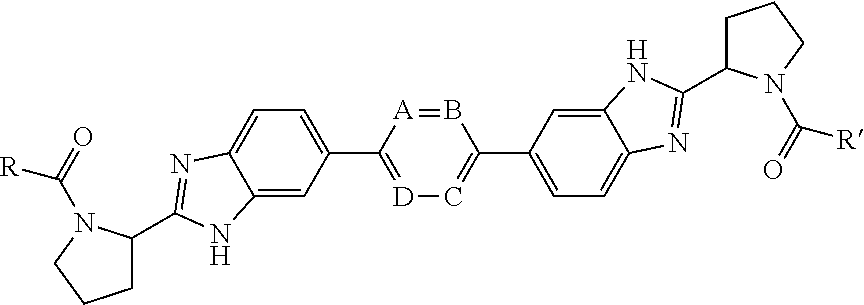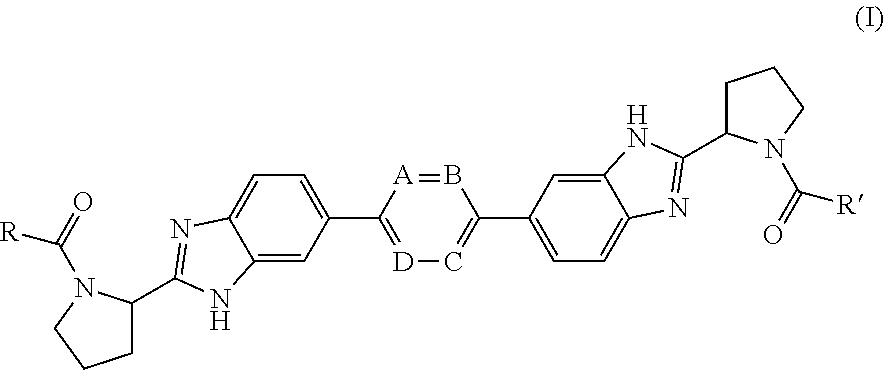Bis-Benzimidazole Derivatives
a technology of benzimidazole and derivatives, applied in the field of bisbenzimidazole derivatives, can solve the problems of high rate of chronic infection, existing infections will continue to present serious medical and economic burden, combination therapy has significant side effects, and neuropsychiatric symptoms,
- Summary
- Abstract
- Description
- Claims
- Application Information
AI Technical Summary
Benefits of technology
Problems solved by technology
Method used
Image
Examples
example 1
Synthesis of Compounds of Formula V
[0091]1.1 Preparation of Intermediate II
[0092]To a solution of Boc-L-Proline (2669 mg, 12.4 mmol) in pyridine / DMF (30 mL, 1 / 1) was added di(1H-imidazol-1-yl)ketone (2205 mg, 13.6 mmol). The mixture was stirred at 45° C. for 2 hours. 4-bromobenzene-1,2-diamine (2319 mg, 12.4 mmol) was added and the mixture was stirred at ambient temperature overnight. The solvent was removed and the residue heated in acetic acid (15 mL) at 100° C. for 30 minutes. After concentration of the residue, the mixture was partitioned between ethyl acetate and a saturated sodium bicarbonate solution. The organic phase was separated and washed with water. After drying over Na2SO4, the mixture was filtered and the filtrate was concentrated in vacuo. The obtained residue was purified by flash chromatography using DCM / EtOAc 90 / 10 to 50 / 50, resulting in compound II (3.146 g, 69%).
[0093]1.2 Preparation of Intermediate III
[0094]To a mixture of II (200 g, 546 mmol), potassium acetat...
example 2
Synthesis of Compounds of Formula I
[0100]2.1. Preparation of Compound nr. 1
[0101]To a solution of XVIII (250 mg, ˜0.40 mmol) in dry DMF (5 mL) was added DIPEA (0.734 mL, 4.439 mmol), HATU (527 mg, 1.4 mmol) and acid (389 mg, 2.22 mmol). The mixture was stirred for 2 hours at room temperature. DCM was added and the mixture was washed with saturated NaHCO3 (2×20 ml). The organic phase was dried on MgSO4 and after filtration, concentrated in vacuo. Purification was performed by silica gel chromatography (0-8% MeOH in DCM), resulting in compound 1 as a solid (200 mg, 0.261 mmol). Rt: 4.99 min. m / z=: 765.4 (M+1)+ Exact mass: 764.4
[0102]1H NMR (400 MHz, DMSO-d6) δ ppm 12.29-12.65 (2H, m) 8.21-8.73 (4H, m) 7.89-8.20 (2H, m) 7.55-7.75 (2H, m) 6.78-7.50 (2H, m) 5.16-5.49 (2H, m) 4.01-4.15 (2H, m) 3.78-3.95 (4H, m) 3.55 (6H, s) 2.17-2.37 (4H, m) 1.84-2.16 (6H, m) 0.77-0.96 (12H, m)
[0103]2.2 preparation of Compounds 2 to 9
[0104]Compounds 2 to 9 as listed in table 1 were synthesized using the p...
example 3
Anti-HCV Activity of Compounds of Formula I
[0111]The compounds of formula (I) were examined for inhibitory activity in the HCV replicon. This cellular assay is based on a bicistronic expression construct, as described by Lohmann et al. (1999) Science vol. 285 pp. 110-113 with modifications described by Krieger et al. (2001) Journal of Virology 75: 4614-4624, in a multi-target screening strategy.
[0112]In essence, the method was as follows:
[0113]The assay utilized the stably transfected cell line Huh-7 luc / neo (hereafter referred to as Huh-Luc). This cell line harbors an RNA encoding a bicistronic expression construct comprising the wild type NS3-NS5B regions of HCV type 1b translated from an Internal Ribosome Entry Site (IRES) from encephalomyocarditis virus (EMCV), preceded by a reporter portion (FfL-luciferase), and a selectable marker portion (neoR, neomycine phosphotransferase). The construct is flanked by 5′ and 3′ NTRs (non-translated regions) from HCV type ...
PUM
 Login to View More
Login to View More Abstract
Description
Claims
Application Information
 Login to View More
Login to View More - R&D Engineer
- R&D Manager
- IP Professional
- Industry Leading Data Capabilities
- Powerful AI technology
- Patent DNA Extraction
Browse by: Latest US Patents, China's latest patents, Technical Efficacy Thesaurus, Application Domain, Technology Topic, Popular Technical Reports.
© 2024 PatSnap. All rights reserved.Legal|Privacy policy|Modern Slavery Act Transparency Statement|Sitemap|About US| Contact US: help@patsnap.com










